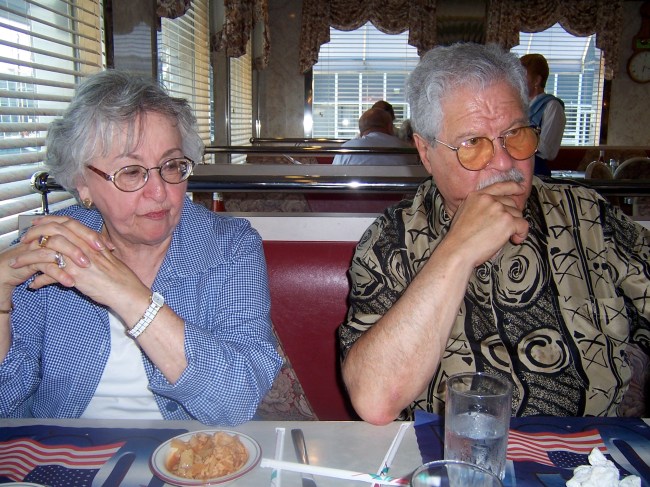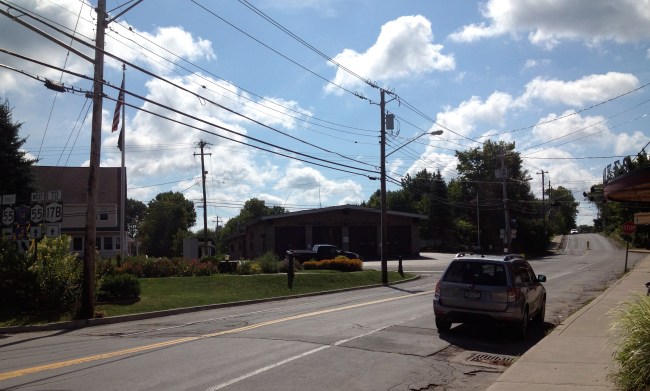Embroidery. That is the first word that comes to mind when I think of my Dad. The second is textiles. These words define his profession. Yes, he loved my Mom, my siblings and I. But it was the embroidery and textile industry where he spent most of his time. My Dad’s life followed the course of the American textile industry.
When I was young, my Dad and a friend, Marty T., owned an embroidery shop in New Jersey on the corner of 60th Street and Bergen Boulevard in Hudson County. At that time Union City was called the Embroidery Capital of the World, and North Bergen had many shops as well.
I remember going to visit him at work on rare occasions. First you entered a front room that showed samples of the work they had finished. My Dad and his partner did lots of patches for the Army and Navy, as well as fabric. I still have some curtains I made from fabric made in my Dad’s shop. Even though it is more than 50 years old, it is in great shape.
 Valance made from embroidered fabric from my Dad’s shop.
Valance made from embroidered fabric from my Dad’s shop.Behind the showroom was a large room with the big embroidery machines. We knew not to ever touch them. The rule was to walk down the middle aisle…turn right and go into the office.
But one time, the machines were down and being cleaned. So my Dad took me around and explained how they worked. How the cards told the machines where to stitch on the fabric. I was intrigued. Later I learned that these cards used on the jacquard embroidery machines helped in the development of computers!
When I was about 8, the business had a crisis. Marty and Dad and taken in a third partner. This guy was a crook, a ‘goniff. ‘ He embezzled money from the firm and disappeared. He did not pay any of the company’s bills. It was awful for my family. Dad held three jobs through the help of friends and family. We never saw him. He borrowed money from family members to pay off the debts, and later spent many years paying back these loans. It was a tremendous burden that, although it scarred my Dad, it did not stop him. He was persistent.
Finally he once again got a job in the textile embroidery business with a company called Hanna. Mario, who owned Hanna, was both a mentor and supporter of my Dad. Dad started in production and moved to sales with Mario’s support. Now Dad was now traveling around the country selling embroidery, checking the manufacturing and dealing with clients.
Although he learned to love sales, at first he was scared. He often told us how he walked around the block three times before he entered his first sales appointment.
At the time New Jersey and New York City were the hub of the textile industry of America. North Carolina and Rhode Island had many textile mills. And Dad traveled to these states often. However, over time the American textile industry declined as more and more fabric was imported from over seas.
Dad did not stay with Mario, he moved on to a company in New York City. Arnie, the owner, became Dad’s new mentor and supporter. Eventually my Dad became manager of one of this company’s divisions. He eventually bought this part of the company, started his own company and expanded it. His niche was swimsuits and lingerie fabric. He traveled not only in the US but also to Europe, primarily Italy. He had many friends in the textile industry. I loved the summer I worked for him in Manhattan. The many people I met did not forget me either. When I got married, three different designers sent me peignoir sets for my honeymoon.
Many years later I went to Italy. My Dad said, “Go to Como. It is the most beautiful city. And it is where the silk industry of Italy started.” In fact, Como was known as the City of Silk.
 Book from the Silk Museum in Como.
Book from the Silk Museum in Como.So I went to Como. Our tour guide had studies textiles at the university in Como. He took us to the Educational Silk Museum. Even though he did not speak English and I do not speak Italian, we understood each other. Why? Because the machines were so like the machines in my dad’s embroidery shop from so long ago. I knew all about jacquard pints and how the cards told the machines where to stitch. I recognized many of the pieces of equipment. My husband just stood to the side as we analyzed everything. I bought books about the textile/silk museum for both my Dad and for me.
My Dad spent his entire adult life in the American textile industry. But even before he served in Korea for the US Army, he had one other experience in the ‘textile’ business. When he was a teenage, Dad had the opportunity to work in a textile warehouse one summer. One of his best buddy’s father owned the company. Every day they went to work in a giant empty warehouse where the two of them played catch. But every once in a while a large shipment would come in. They would stencil all the boxes with words saying that there was textile machinery inside.
Years later, Dad was reading a book and started to laugh. The book told about the smuggling of weapons to Israel before the 1948 war…the warehouse my Dad worked in that summer was one of those known to have shipped arms to Israel.
The American textile industry not only gave my Dad and my family a great life, it also provided my Dad with one of his favorite personal stories.
(Thanks to my brother for remembering with me.)






